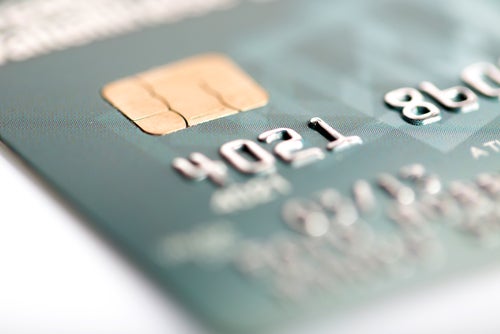
If you have a credit card account, by now you will have received a new card with a chip on it, replacing your magnetic-striped card. These cards still have a magnetic stripe on them, but on the front is a prominently displayed chip. Why are all the banks replacing your cards?
Magnetic Stripes Are Easy to Hack
Credit and debit card magnetic stripes contain three “tracks” of information. The information is read during a card swipe, and information from magnetic stripes is transmitted to merchants during a swipe in clear text (unencrypted) format. The Target breach in Christmas season 2013 happened because fraudsters installed malware on the POS terminals and collected this unencrypted information.
U.S. credit cards were the number one target of fraudsters in the recent past because the information collected from a magnetic striped card was so easy to use to create new cards. There were even online websites where you could send in the information and have a card duplication company create a new card for you.
Chipped Cards are Tougher to Counterfeit
Chipped cards transmit different encrypted data for each transaction, making them very difficult to clone or use fraudulently. If data from a single transaction is stolen, as was the case with the Target hacking incident, the data could be used to clone a card, but the data would be identified as “used before” and the card transaction would not be authorized.
Most other countries have been using chipped cards for years. The U.S. was slow to transfer over to chipped cards because of the number of merchants who had magnetic stripe terminals. However, the amount of credit card fraud ($7.1 billion in 2013), has forced the change, despite the large cost of upgrading to chipped cards and the corresponding POS terminals ($8 billion and $6.8 billion respectively).
Liability of Fraudulent Transactions Shifts From Bank To Merchants in October 2015
As of October 1, 2015, merchants who accepted non-chipped fraudulent cards will be responsible for any charges made. Before October 2015, big banks absorbed fraudulent charges made when a card was counterfeited. There is no law requiring banks to issue cards, the switch is purely voluntary. Likewise, there is no law requiring merchants to spend the money to switch over to chip-reading terminals. However, merchants have a large monetary impetus to switch over to chipped cards/POS terminals.
What If I Don’t Have A Chipped Card Yet?
If you’ve noticed, most terminals purchased by merchants still read magnetic-swiped cards, so you will still be able to use your old mag stripe credit card until your new chipped card arrives from your bank.
Will I Get a Chipped Debit Card?
Yes, in addition to credit cards, all debit cards will also get a new chip so they can be used at merchants with chipped terminals. However, not all debit cards are expected to be replaced by the end of 2015. ATMs will be next to follow suit in switching over to chipped card readers over magnetic striped cards, though ATM upgrades will lag behind terminal upgrades, time-wise.
Many mag-stripe ATMs allowed an initial swipe of a card, then would give you the card back before the transaction had ended, preventing the expense of issuing new cards to those who forgot to remove them when they were finished. However, since chipped cards need to be in the ATM the entire time the transaction is being conducted, you will need to remember to remove the card once you are finished.
Will Chipped Cards Make All Fraud Go Away?
Chipped cards are not impossible to make and credit card fraud in countries other than the U.S. grew 11% in 2013 to $6.8 billion.
Consumer liability is $50 for debit cards and 0% liability for stolen credit cards. If you are the victim of fraud, it can be an annoying, time-consuming process to rid yourself of fraudulent credit card charges. Many of us have automatic charges to our cards for things like Internet TV subscriptions or utility bills and switching over from old to new card numbers is a hassle.
To protect yourself from credit card fraud:
- Check your accounts for unauthorized charges. While you are not liable for such charges, you only have 60 days to notify your bank in the case of stolen debit cards, and 2 business days if your debit PIN has been stolen.
- Report suspicious charges immediately. If you find fraudulent charges, you should consider canceling your card and changing your PIN to prevent further fraud.
Chipped Card PINs
In most of the world, chipped credit cards require a PIN in order to use the card; in the U.S. most chipped cards will continue to be authorized using a signature. Entering in a PIN is one more step in eliminating fraud, and U.S. banks plan on eventually going to PIN authorizations, but U.S. banks and merchants are taking things one step at a time. Eventually, the U.S. will transition to using chip-and-PIN transactions only.
What About Online And Phone Purchases?
If your chipped credit card information is stolen, thieves may not be able to create a new credit or debit card, but they may still be able to use your card information. In these cases, a chipped card is no more secure than a magnetic striped card. Safeguarding your credit card information, especially online, is always going to be critical. All it takes to forge your credit card information is to know the credit card number, the expiration date, the CVV number and your zip code for “card not present” transactions to go through.
Will The New Cards Affect My Credit Score?
No. As with cards that are replaced because they were lost or stolen, getting a new replacement card, even if the credit card number is different than the one being replace, will not affect your credit rating. There will not be a new account placed on your credit report.
Questions about credit repair?
Chat with an expert: 1-800-255-0263






